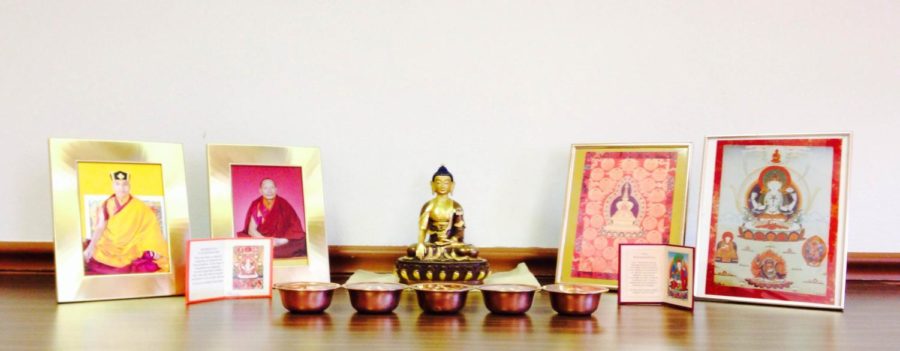Karma Kagyu club offers meditation, Buddhist practices
Shakyamuni Buddha, a historical figure, is always central and with water offerings. The Karmapa, on the left, is the head of Karma Kagyu lineage — similar in importance to the Dalai Lama. The shrine must represent the body, speech and mind of the Buddha to be represented for it to be a true shrine.
September 24, 2014
When it comes to joining student organizations at Iowa State, the opportunities are vast.
One organization, Karma Kagyu, focuses on Tibetan Buddhism with the goal of teaching anyone who wants to learn more about the religion.
The group was established in Ames in 1995 by Tim Mullaney, who was then a doctoral student, and has been at ISU since 1996.
“Originally, we were the English-speaking branch of the Lotus group,” Mullaney said.
Victoria Kichler, year-two veterinary student, acts as president of the group. The group has about five to 10 people who attend on a regular basis with three to five who are ISU students, Kichler said.
Mullaney said the group is not very high-profile and that it is trying to gain more members.
Kichler adopted the religion a few years ago when she was in Miami. She joined Karma Kagyu a semester after she started at Iowa State.
“I was looking for a group I could go to,” Kichler said. “[Karma Kagyu] is the same denomination as the group I was in in Miami.”
The group meetings are broken into three parts: Tibetan meditation, traditional meditation and study and discussion.
Tibetan meditation involves chanting, visualizing, mantras and Chenrezig practice with the purpose to awaken compassion.
Kichler believes a lot of students would benefit from meditation.
“We’re all very stressed, and I think learning meditation would be really great,” Kichler said. “You need to relax and make your study effective when you relax.”
Karma Kagyu meets at 9 a.m. on Sundays in room 3538 of the Memorial Union.
Kichler said the group is always welcoming new members but encourages those interested to sit in the meditation session at 10 a.m. with a cushion.
“The chanting at 9 a.m. is in Tibetan. It can be overwhelming and weird and people can be turned off at first,” Kichler said.
The purpose of chanting, in most Buddhist practices, is to prepare the mind for meditation. Some practices use chanting for ritualistic purposes.
Kichler said she is hoping to get the message out to the students.
“I’m the only student who attends regularly,” Kichler said. “I don’t think students really know that we exist.”
As for the future of the club, Mullaney said they are still in the planning stages of getting a speaker to come visit in the spring.







